HIS 338 Final
1/131
Earn XP
Description and Tags
The Roman Empire from Caesar's assassination to the fall of the Western Empire
Name | Mastery | Learn | Test | Matching | Spaced |
|---|
No study sessions yet.
132 Terms
Civil war between Pompey and Caesar
decisive win by caesar
marks end of republic by paving way for caesar’s dictatorship
worsens factionalism
“Dictator in perpetuity” / “Perpetual dictator”
confirms that republic is dead and caesar now has sole power
people hate the way he is dictator, his tendency to grant clemency means he leaves his enemies alive
finally provokes senators to kill him, want to hold on to power
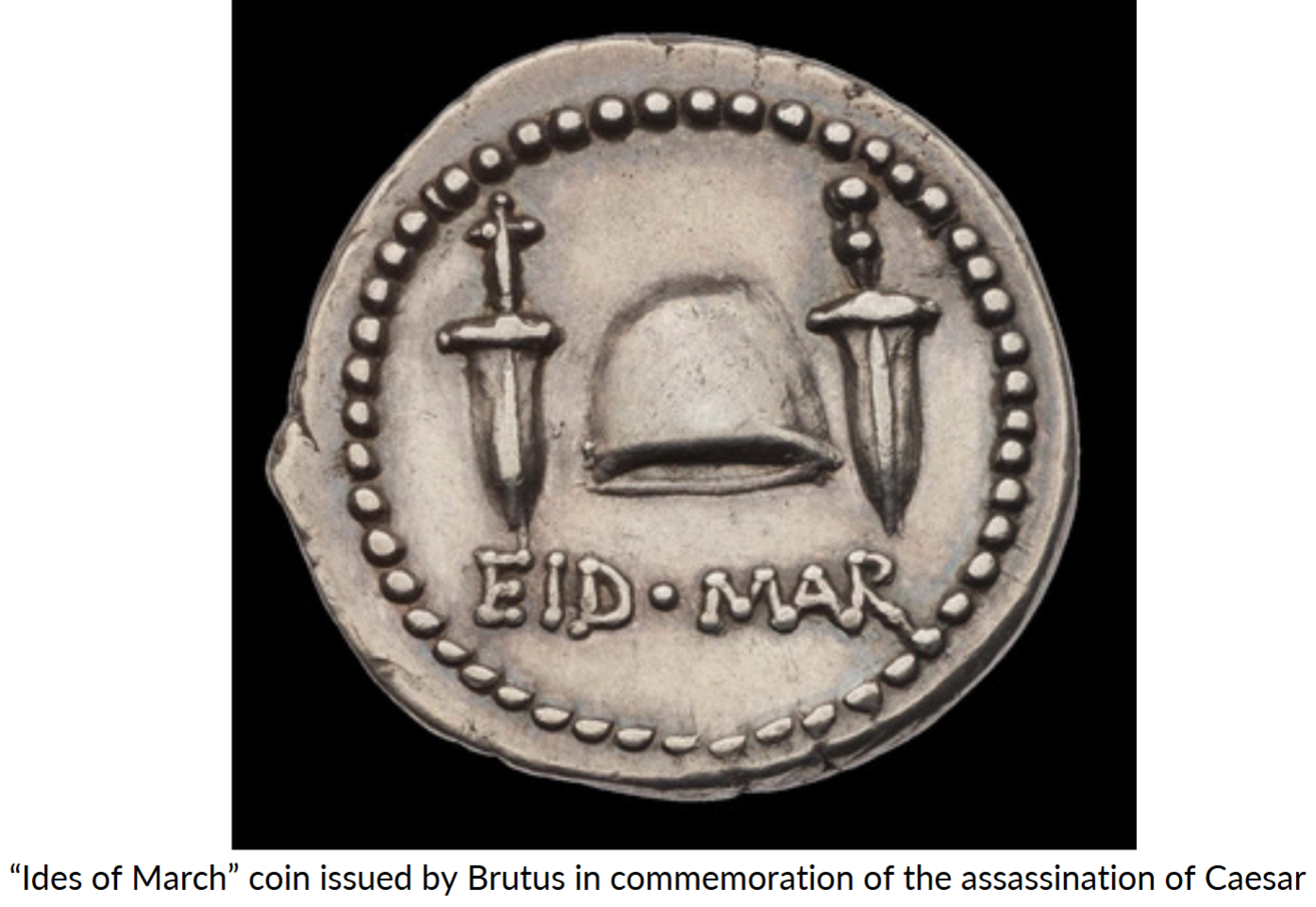
Assassination of Caesar
people hate the way he is dictator, his tendency to grant clemency means he leaves his enemies alive
finally provokes senators to kill him, want to hold on to power
political violence of late republic
senators refused to place caesar’s personal interest above that of everyone else
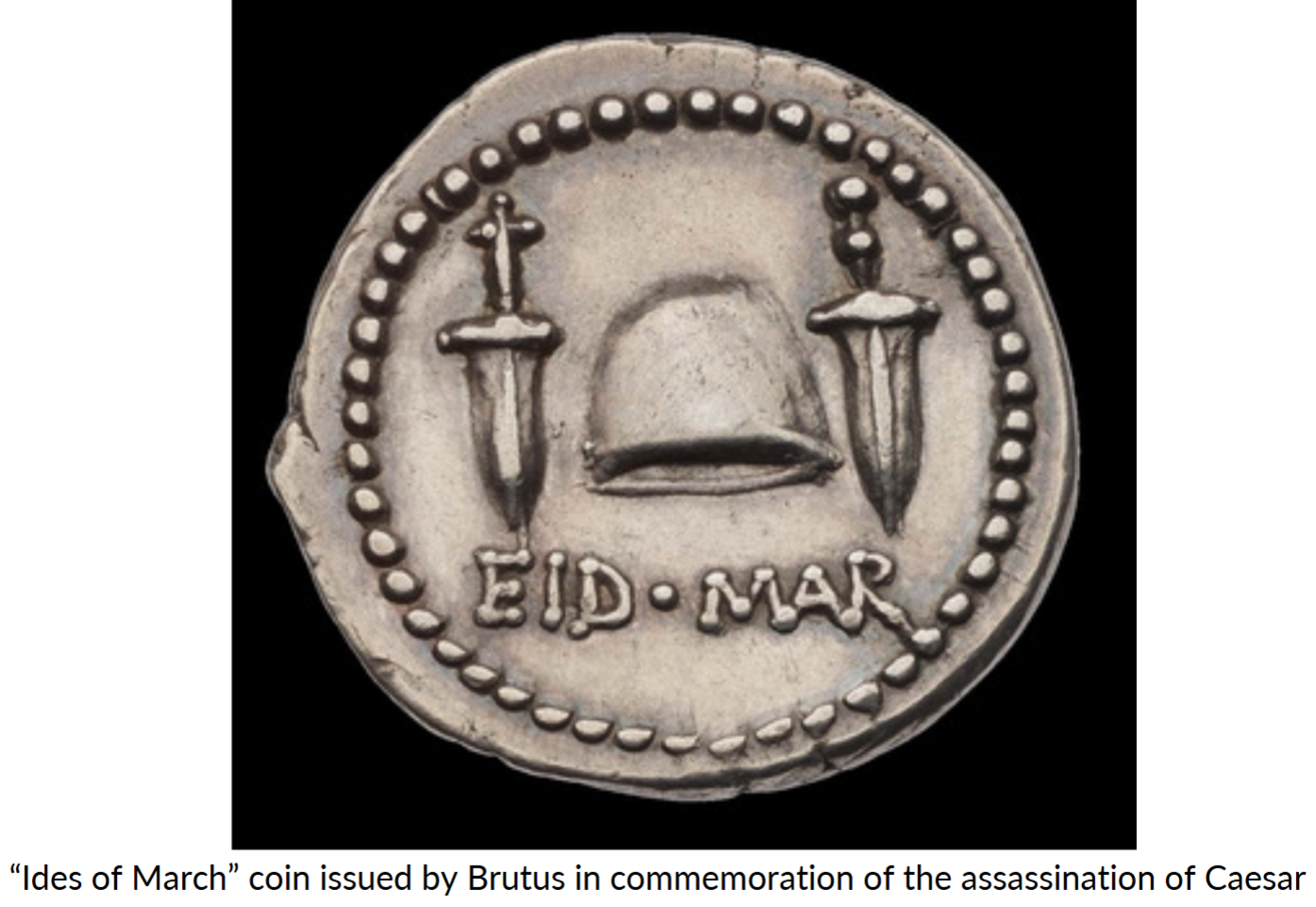
The “Liberators” (Brutus and Cassius); “Liberators’ Civil War”
Liberators: Caesar’s assassins
See themselves as having saved Rome from a tyrant
Public turns on them after assassination, they flee
2nd triumvirate forms to go after liberators
Defeated so badly by Mark Antony and Octavian that they kill themselves
End of Republican cause
Ides of March coin, freedman’s cap representing liberty
Mark Antony
Caesar’s co-consul, rises to prominence after assassination
Part of second triumvirate, rival of Octavian
Divided rule: Antony in East and Octavian in West, struggle for sole power
Octavian paints Antony as non-Roman because of his ties to Eastern allies, including Cleopatra
Defeated at Actium, flees to Egypt, kills self
Lepidus
Member of second triumvirate
Tries to displace Octavian after Sextus Pompey defeated
Exiled
Without third member, second triumvirate cannot stand
Gaius Octavius → Octavian
Caesar’s grandnephew
adopted posthumously, takes name Octavian
Member of second triumvirate
With triumvirate, goes after opponents, wants to avenge caesar
Rivals with Mark Antony
Paints him as non-Roman because of connections with Eastern allies in order to reduce appearance of civil war
Antony’s relationship with Cleopatra dishonors Octavian
Eliminates Lepidus and Mark Antony, becomes sole major figure
Closes doors of Temple of Janus, representing state of peace between rome and the world
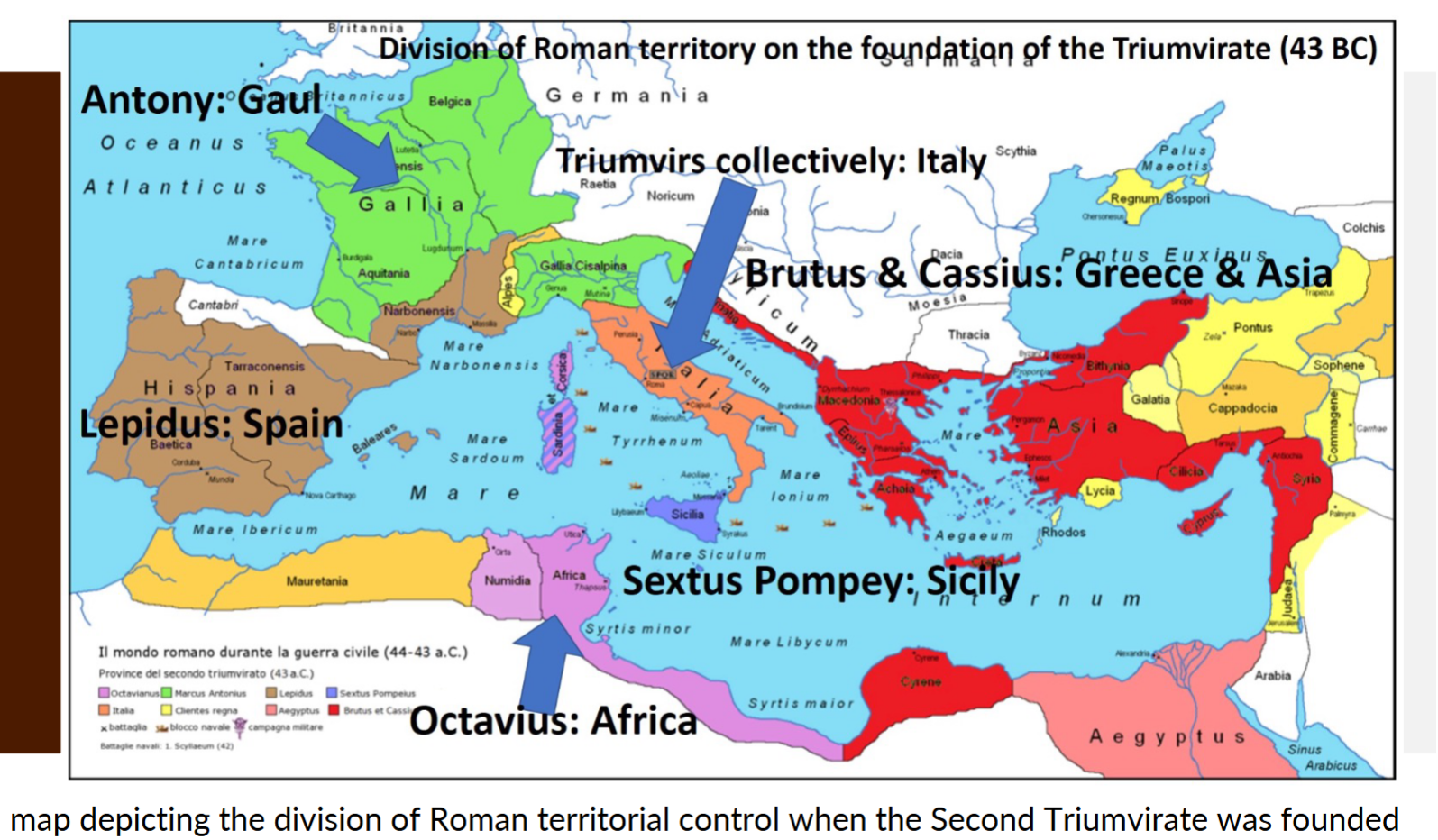
Second Triumvirate
Starts as private negotiation, but unlike first, later formally ratified by law
Octavian, Mark Antony, and Lepidus
Extensive powers, few checks
Priority is to pursue and punish assassins
Go after opponents and rivals
Brutus and Cassius still control east, where most wealth is
Triumviri reipublicae constituendae (“triumvirs for the restoration of the state”)
From ratification of second triumvirate
extensive powers, few checks
Priority is to pursue and punish assassins
Deification of Caesar
Deified by senate
Elevates Octavian’s status as “son of a god”
set stage for deifying emperors, divine legitimacy
divi filius (“son of a god”)
status of Octavian after deification of Caesar
Gives him more prestige and authority
Gives him more right to eventually claim sole power and rule as princeps
Battle of Philippi
Antony and Octavian meet Brutus and Cassius
Brutus and Cassius eventually commit suicide
End of Republican cause
Avenged Caesar’s assassination
Perusine War (rebellion of Lucius Antonius and Marcus Antonius’ wife, Fulvia)
Brief rebellion suppressed by second triumvirate
Eventually led to reconciliation between Antony and Octavian
Sextus Pompey (son of Pompey the Great)
Son of Pompey the Great
Octavian divorces his relative, offends him
Consul Agrippa defeats him, he flees to Asia Minor and is executed
His defeat prompts Lepidus to try to displace Octavian, highlighting divisions within second triumvirate
Agrippa (Augustus’ military second-in-command)
defeats sextus pompey
His victory encourages lepidus to try to displace octavian, highlighting divisions within trimuvirate
Cleopatra
Queen of Egypt
Personal relationship with mark antony
Octavian wants sole power and is offended by Mark antony dishonoring him and his sister, starts propaganda campaign
Defeated at Actium and kills self
Egypt and its wealth seized by Rome, Octavian now sole ruler
“First Settlement”
Octavian formally hands back authority to the senate
granted title of Augustus (related to respect, reverence)
Showing efforts at power-sharing
presents self as continuing efforts to restore republic, not as beginning a new system
Attempt at maintaining stability
Begins Augustan Era
Augustus
Title granted to Octavian via the first settlement
Related to honor, respect, reverence
Intended to symbolize break with Octavian’s violent past
Peace, stability restored
“Second Settlement”
Augustus formally resigns the consulship
Augustus receives greater imperium and tribune power
tribunician power: power to convene the senate, veto legislation, and control elections.
greater imperium: power to command armies and govern provinces
Powers granted for life
Augustus parades tribune power, not greater imperium because it is more modest and protects ordinary citizens
Makes Augustus the most powerful man in Rome, while ostensibly upholding republican values
Augustus now has legal basis for permanent power
Pater Patriae (father of the fatherland)
A title of honor, meaning 'Father of the Country' or 'Father of the Fatherland.'
signifies that the individual was seen as a protector and benefactor of the Roman state.
symbol of legitimacy
solidifies his image as the restorer of the Republic and the guardian of Roman citizens.

Pax Augusta (Augustan Peace)
Period of relative peace and stability in the Roman Empire
Facilitated economic prosperity, infrastructure development, and flourishing of arts and literature.
Propaganda: Augustus portrayed himself as the bringer of peace and order, which helped legitimize his rule.
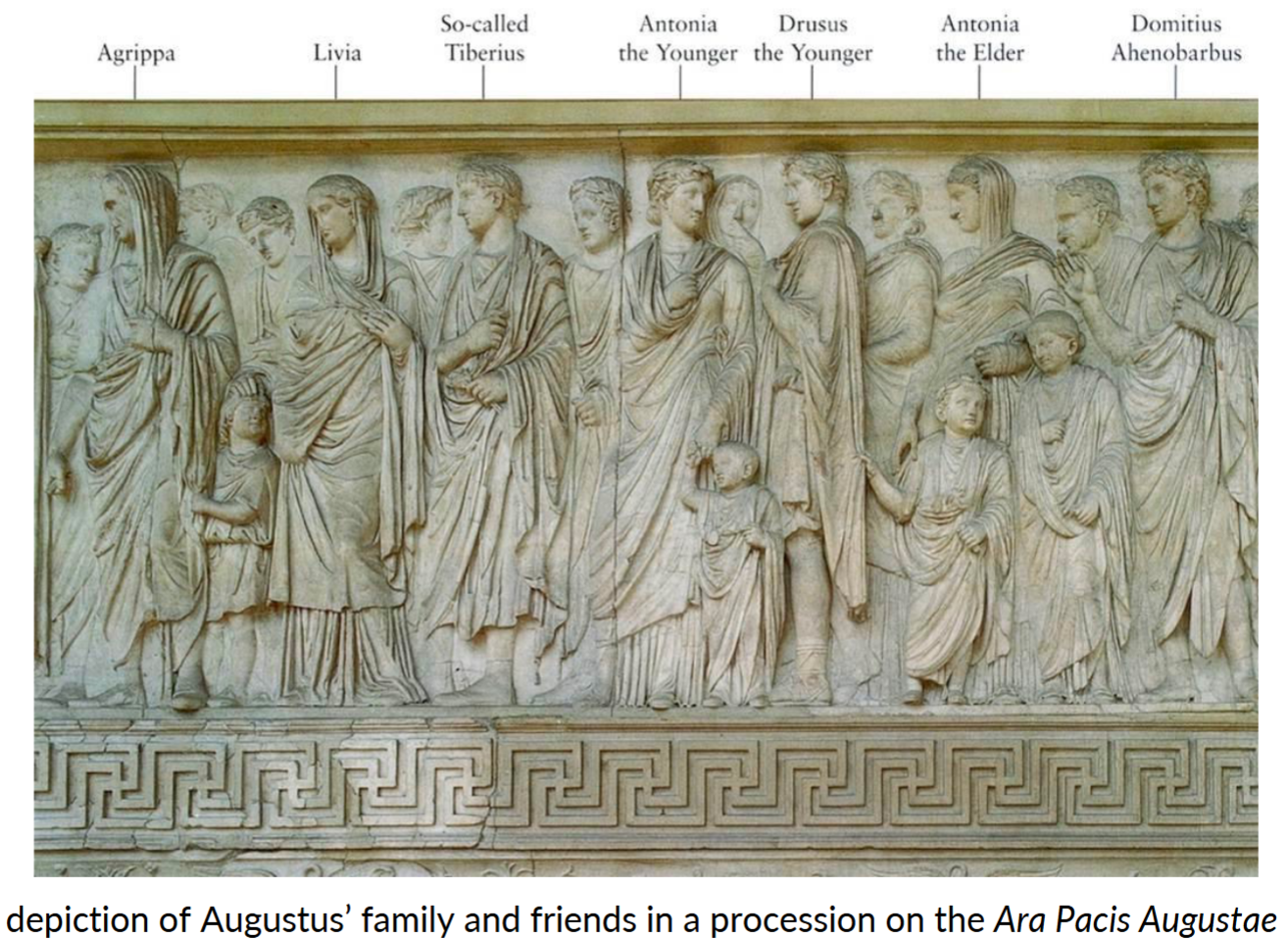
Ara Pacis Augustae (Altar of Augustan Peace)
Serves as a symbol of peace, prosperity, and the Augustan Golden Age.
Bottom: leaves, fertility of Rome under Augustus
Top: Historical and Myth
Procession of imperial family
First depiction of children in Greek or Roman monuments, promote family because of declining birthrates
Relief of Pax
Peace and prosperity under Augustus
Reinforces image of restorer of the republic
Res Gestae Divi Augustae (Deeds of the Divine Augustus)
Augustus' self-written account of his accomplishments, crafted to promote his image and legacy.
Lists his public works, military victories, and honors received, emphasizing his contributions to Rome.
displayed throughout the Empire to ensure widespread dissemination.
Presents Augustus as a benevolent ruler who restored peace and prosperity
Offers a selective and idealized portrayal of Augustus' life
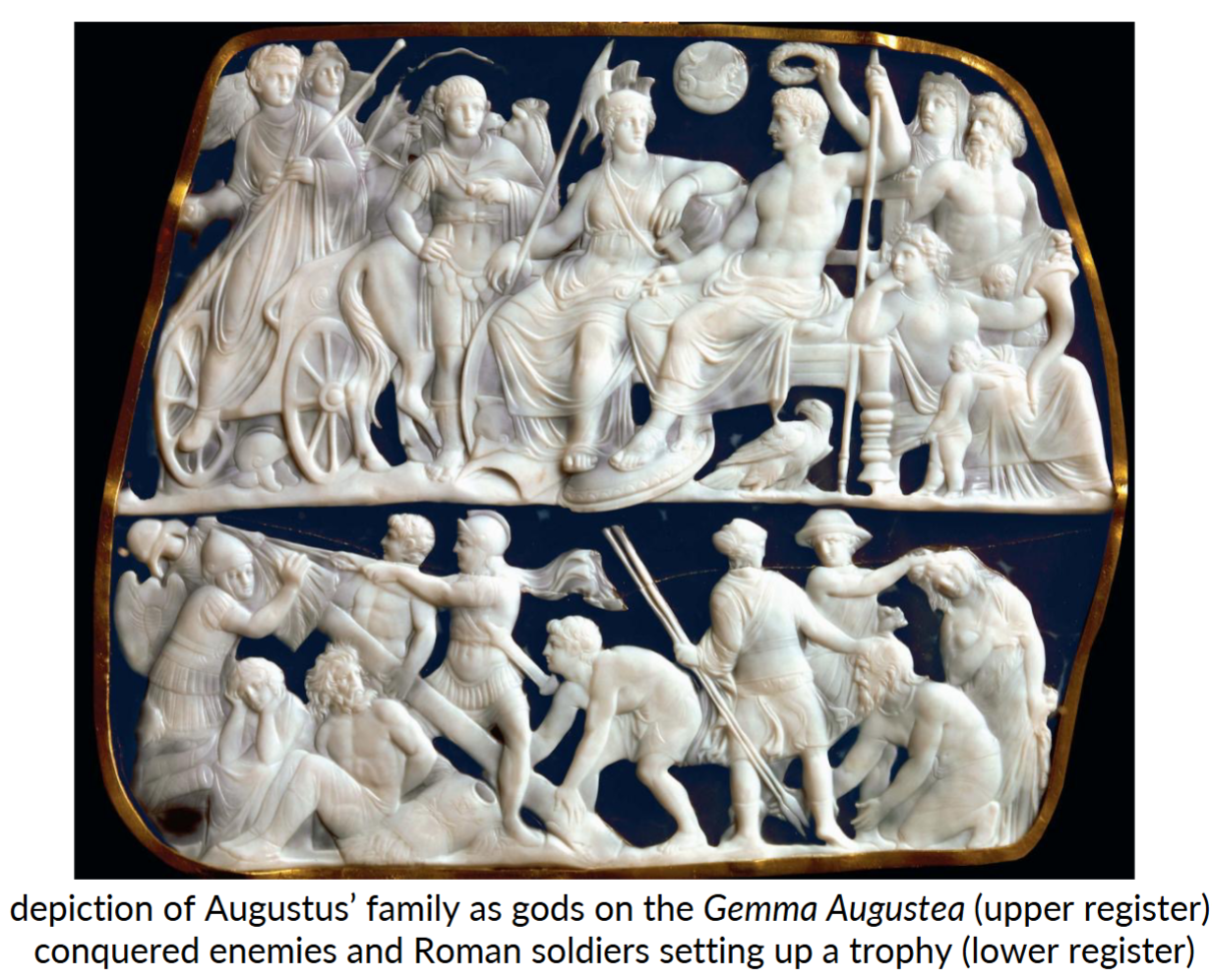
Domus Augusta (household/family of Augustus)
Symbolized center of power and influence
Family portrayed as gods
Emphasis on conquered roman enemies and triumph
Augustan succession
Sources of Augustus’ authority:
Formal:
Originally: extraordinary powers
Powers from holding public offices
imperium
Informal:
Fear of continued war, desire for peace
no memory of another functional system
None could be legally inherited
Romans want to avoid a power struggle after Augustus’ death
Tiberius succeeds him
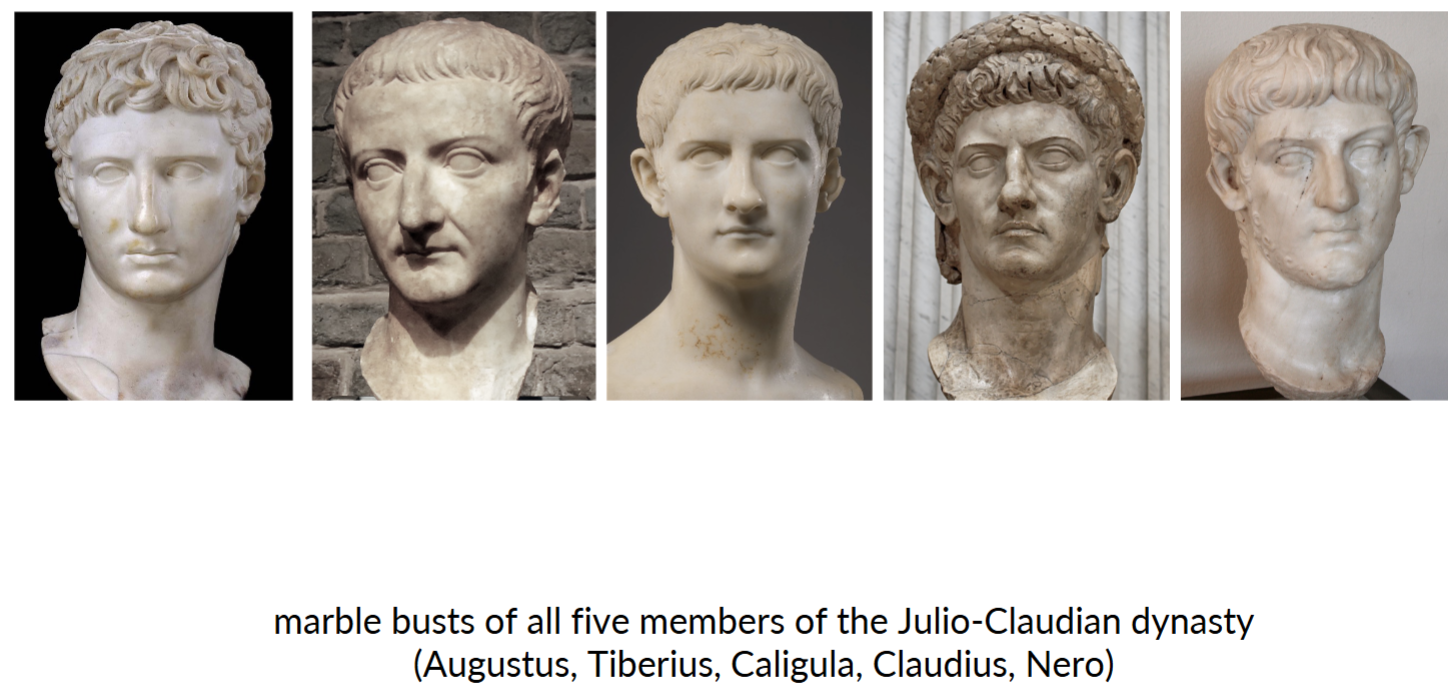
Julio-Claudian dynasty
Starts with succession of Tiberius
Augustus, Tiberius, Caligula Claudius, Nero
Power now theoretically passed in succession, not by vote
Rely on connection to Augustus for legitimacy
Decisive end to republic
Princeps
Bland, informal title meaning “leading figure”
Now, only one princeps
New phase: Principate
Attempt to legitimize imperial power through existing institutions
Symbol of Augustus’ authority and legitimacy
Principate
First phase of the Roman Empire
Retains traditional offices and institutions such as senate
Real authority rests with the princeps
Emphasizes civil rather than military power
Caesar’s assassination revealed dangers of shaming or humiliating peers
Primus inter pares (first among equals)
Suggests that emperor was not an absolute ruler, rather the most respected and influential citizen
Attempt at maintaining facade of republic
Emphasizes civil rather than military power
Caesar’s assassination revealed dangers of shaming or humiliating peers
maius imperium (greater imperium)
greater imperium: power to command armies and govern provinces
Power granted for life
Augustus parades tribune power, not greater imperium because it is more modest and protects ordinary citizens
Makes Augustus the most powerful man in Rome, while ostensibly upholding republican values
Augustus now has legal basis for permanent power
Tiberius
Succeeds Augustus as emperor
Reign consumed by questions about legitimacy
Uncertainty surrounding new system of government
Augustus was right to worry about a power struggle after his death
Orders offensive in Germany to stop soldier uprising, suggesting Rome’s customary use of external war to encourage internal harmony
Praetorian Guard, Praetorian Prefects
They served as personal bodyguards, intelligence gatherers, and enforcers of the emperor's will.
Gained significant political influence, often playing a decisive role in the succession of emperors.
Praetorian Prefects were the commanders of the Praetorian Guard
They acted as the emperor's chief advisors, military strategists, and administrators.
Tiberius’ distrust leads him to rely on Praetorian Guard
Prominence of military basis of imperial power subverts value of civil consensus
Caligula/Gaius
Begins reign as popular young emperor
Tried to restore senatorial prestige and make himself accessible to public
Panders to populace
After serious illness, behavior becomes bizarre and tyrannical
Assassination of Caligula
After serious illness, behavior becomes bizarre and tyrannical
Megalomania and religious arrogance alienates many
deficient military leadership
assassinated by Praetorian Guard
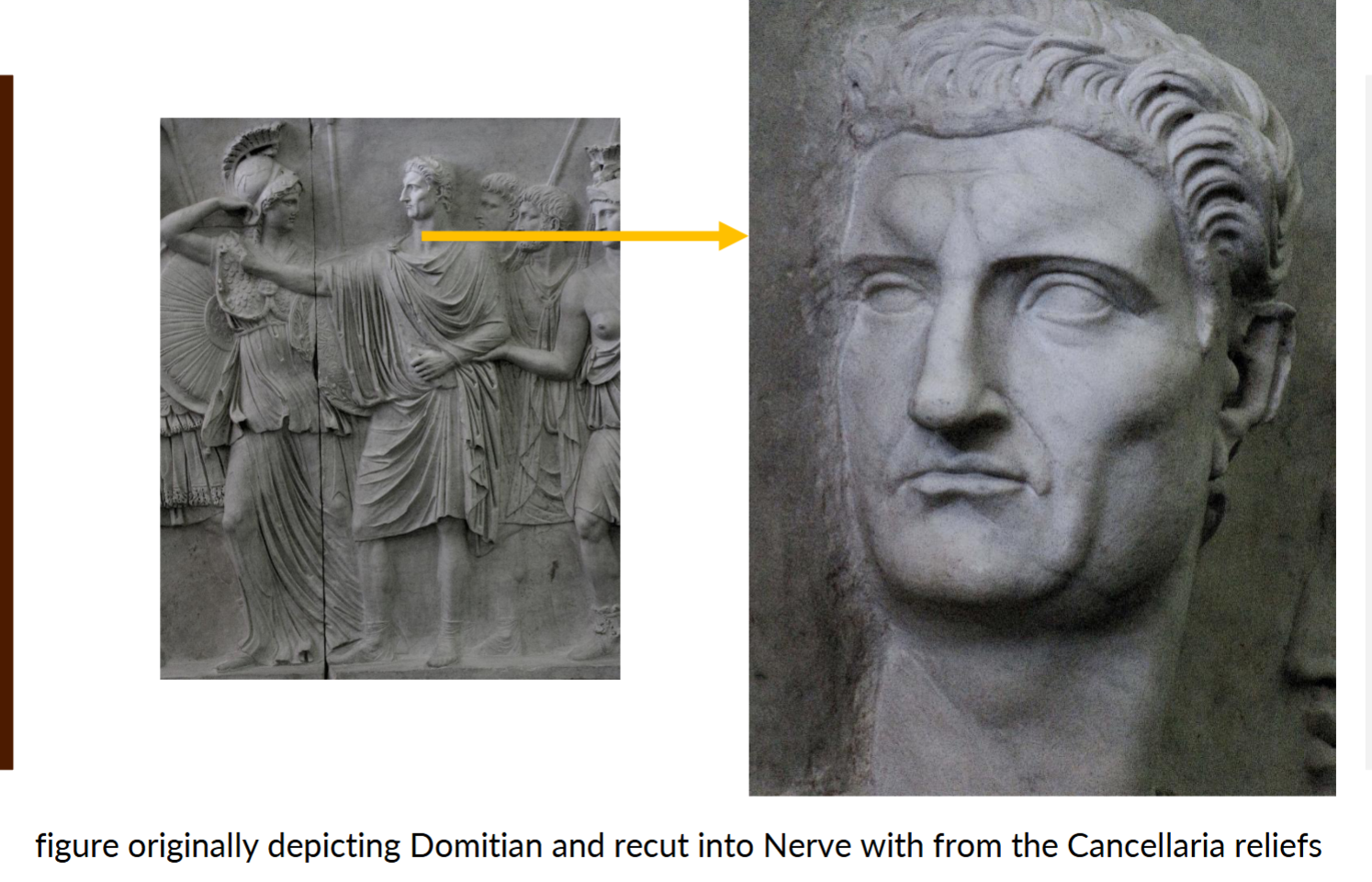
Damnatio memoriae (condemnation of memory), “memory sanctions”
Erasing a person from history by condemning their memory.
Systematic destruction of images, erasure of names from inscriptions, and removal of honors and statues.
Could apply to people who are already dead
Motives:
Political opportunism: use the “clean slate” a new ruler could gain power
Erase enemies or political opponents
Claudius
Was never expected to become emperor, elevation created questions
Two versions of story:
Claudius is a dupe
Claudius is a conniving schemer
Shared Augustus’ concern to expand empire, invades and annexes
Senators and elites hate him
Agrippina (last wife of Claudius and mother of Nero)
Schemed to marry Claudius
Gains greater public visibility than any other woman
Secured succession of son Nero by 53
Nero
Prepared from an early age to be princeps
Reign starts with promise and popularity, but descends into seemingly erratic and tyrannical behavior
Cared more about the arts and showmanship than government and military
Senate disowns him and declares him public enemy, nero kills self
Julio-Claudian dynasty ends
Great fire of 64; persecution of Christians following great fire of 64
Damaged much of Rome
Nero appropriates much of the land to build immense golden house
Proposes plan for rebuilding city that makes people who lost homes camp in his imperial gardens
Makes Christians a scapegoat
Plan backfires because attacks and tortures provokes sympathy

Domus Aurea (Nero’s Golden House)
Great fire of 64 damaged much of Rome
Nero appropriates much of the land to build immense golden house
Proposes plan for rebuilding city that makes people who lost homes camp in his imperial gardens
Buried by successors
Civil wars of 68-69
Nero’s neglect opens door for any commander with willing troops to bid for the principate
Three guys have short reigns, followed by Vespasian who survives and continues to rule
Reveals disunity of empire in general and of the troops
Turmoil makes it clear that dynastic succession was unable to guarantee the best ruler
Galba, Vitellius, Otho
First 3 emperors of year of the 4 emperors
short-lived reigns
Eventually defeated by Vespasian
Conflict reveals disunity in troops and empire as a whole
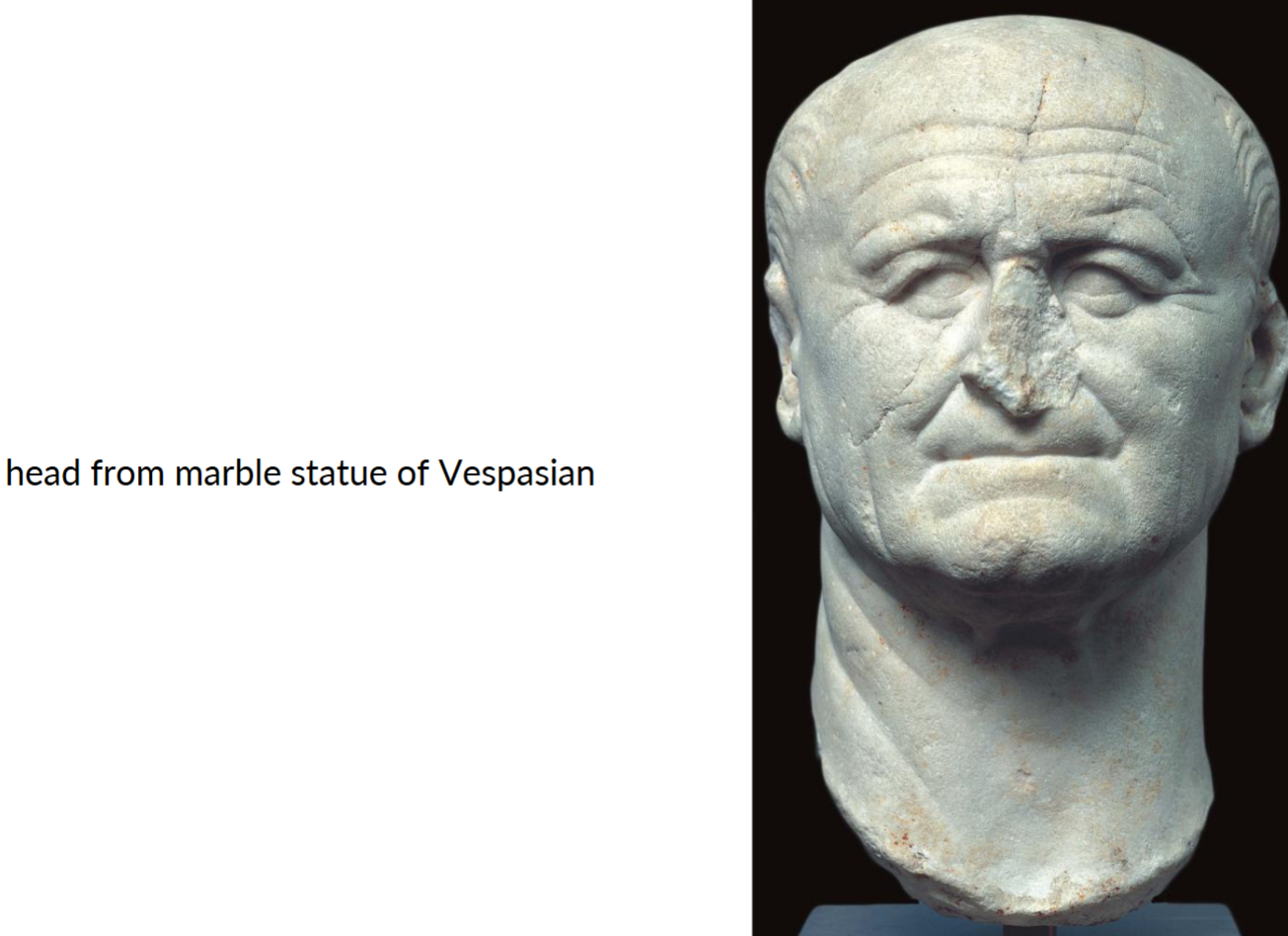
Vespasian
Last of the year of the four emperors
establishes the Flavian dynasty'
Successful general
used qualifications and prior experience to distinguish himself from the unpopular aspects of the Julio-Claudian dynasty
Builds colosseum on site of Nero’s Domos Aurea
Picture: Depicted as old and weathered to show experience and qualifications, not young and irresponsible like Julio-Claudian rulers
lex de imperio Vespadiani
Law specifiying powers and rights of the emperor
Earliest and starkest sign of the principate’s institutionalization
Indicates continuing significance of popular support for the princeps and concern for governmental processes
Emperor’s authority no longer centered on individual or on family
rather, powers justified by law, precedent
Flavian dynasty, Flavii
Jewish revolt / First Jewish war
Destruction of the Temple of Jerusalem
Decimates Judaea’s population
Furthers Jewish diaspora and contributes to distinction of Christians from Jews
Titus
Largely continues father’s policies and approach to imperial power, but dies quickly
In power for 1st Jewish role and Vesuvius
Desire for smooth relationship with Rome’s elites
Domitian
Quickly demands level of power and worship similar to Nero
Titles himself Dominus et Deus
Builds new imperial palace using public money
Reasserts military character of the principate
dominus et deus (lord and god)
Title Domitian gives to himself
Shatters any illusion that the princeps was first among equals
Demanding immense power and worship
Did not learn from Nero’s fate
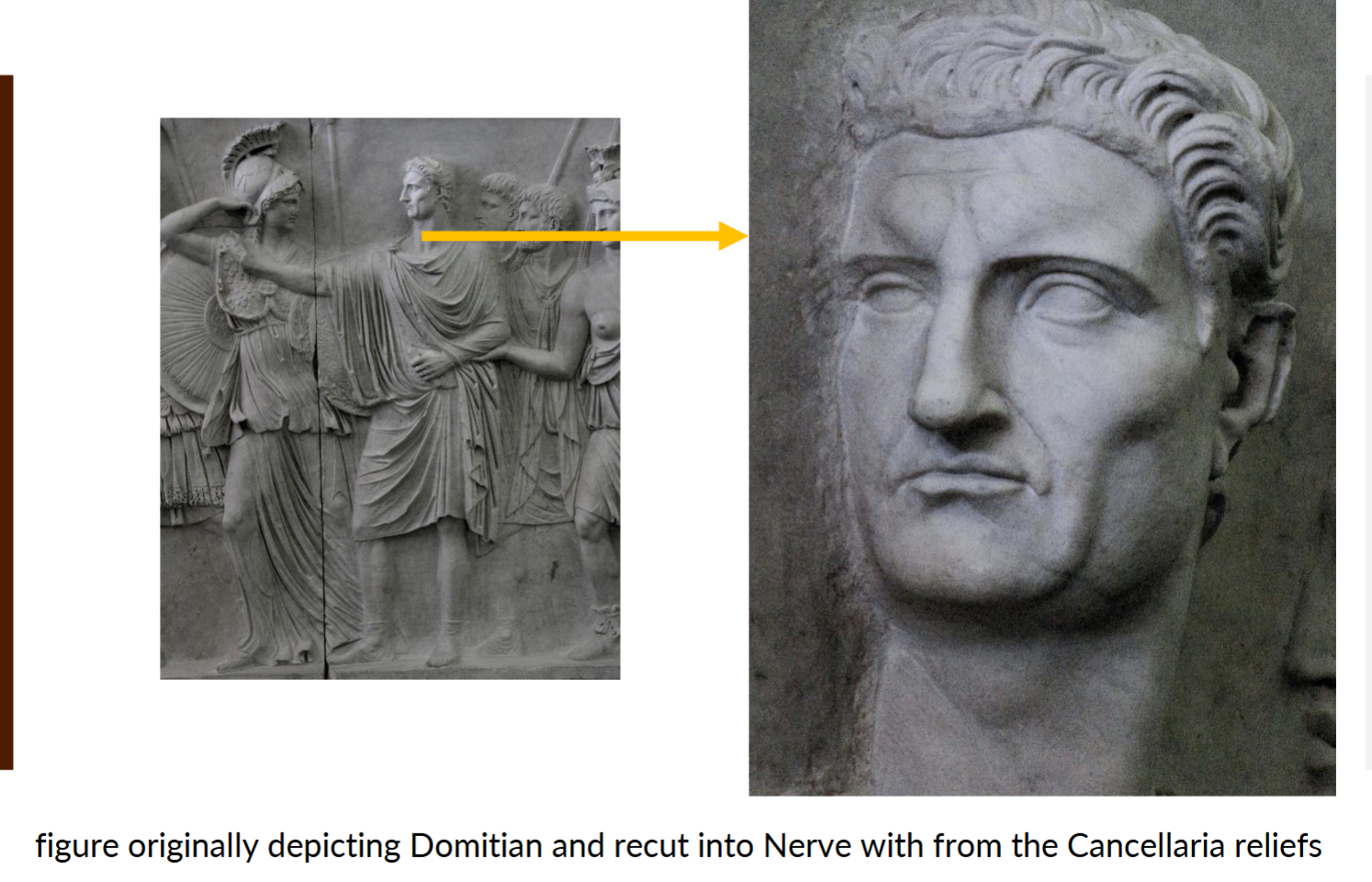
Assassination of Domitian
Paranoia turns him against senators and family
Conspirators include his wife and Praetorian Guard
Populace doesn’t care
Senate imposes memory sanctions (damnatio memoriae)
Statues destroyed, recarved
Forum renamed
Nerva chosen by senate because he is old, experienced and hasn’t angered anyone yet
Picture: Frieze with Domitian’s head recut into Nerva

Nerva
Nerva chosen by senate because he is old, experienced and hasn’t angered anyone yet
Establishes Nerva-Antonine Dynasty
Buys land for distribution to citizens who had none, especially in Rome
Starts tradition of emperors adopting their successors by adopting Trajan and appointing him as next emperor
Garners enough support for empire to survive Domitian’s assassination without civil war
“adoptive emperors”
Nerva starts tradition of emperors adopting their successors by adopting Trajan and appointing him as next emperor
Fictive kinships
the 5 good emperors
Nerva, Trajan, Hadrian, Antoninus Pius, and Marcus Aurelius
Represent high point of imperial stability and success

Trajan
Popular and effective
respected by both army and senate
Rose to prominence as military leader
Borders at greatest extent under Trajan
Several Trajanic military monuments from areas where he campaigned
Building projects
forum and markets
Optimus Princeps
Unique title granted to Trajan by senate
Best Princeps
Symbolizes popularity with senate
Dacian Wars
Waged by Trajan
Success encourages Trajan to further expansion
Creation of province in Arabia further destabilizes area and leads to Parthian War
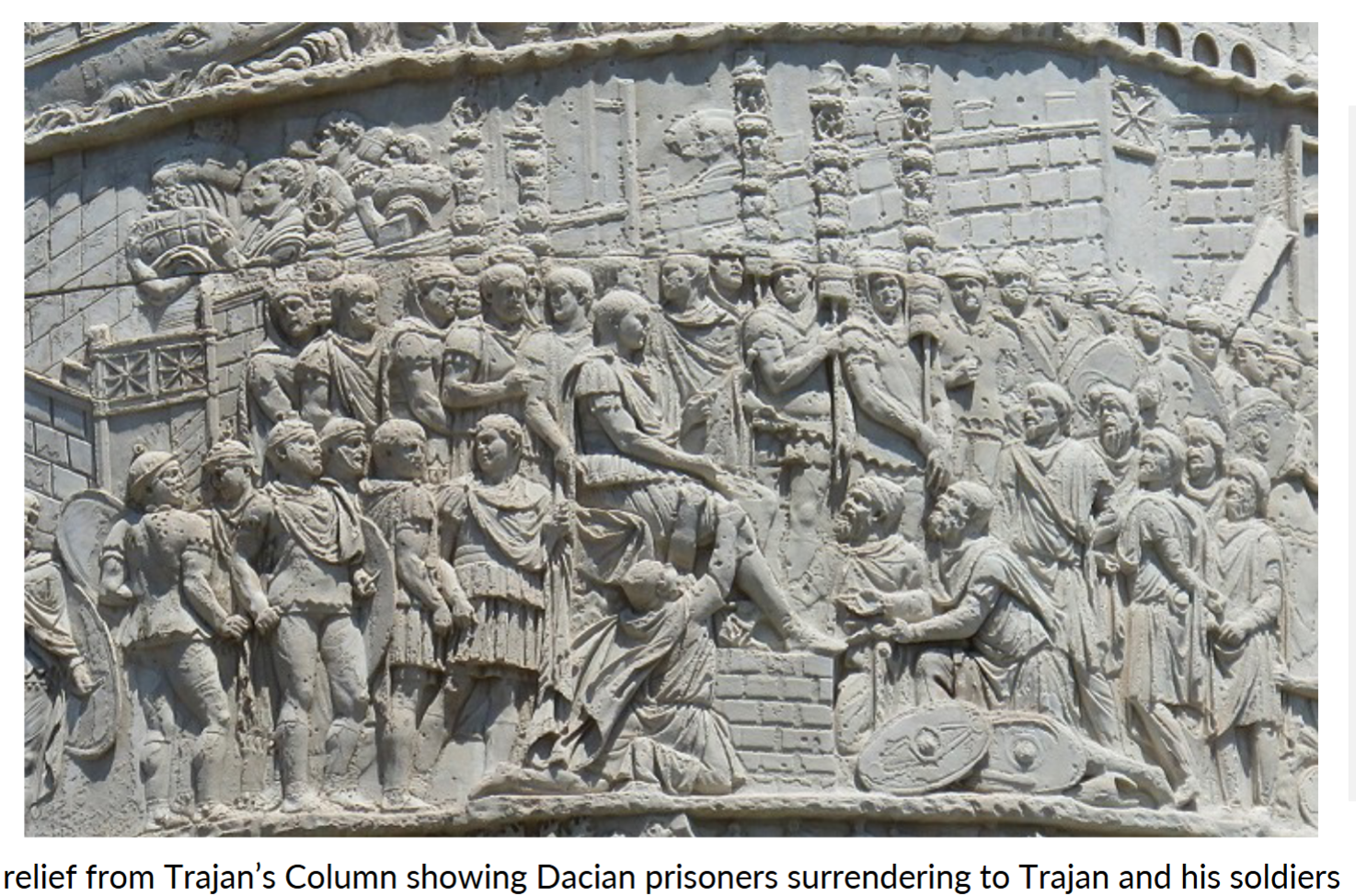
Forum of Trajan, Trajan’s Column
Military victory momuments
Forum of Trajan joins other imperial fora, extends complex and connects to Markets of Trajan
Column commemorates Trajan’s campaigns against the Dacians
Paid for with spoils of the wars
Picture: Relief from column showing Dacians kneeling to Trajan and his soldiers
Emphasizing role of military authority to the Principate
Aggressive military expansionism
Apollodorus of Damascus
Architect of Column of Trajan
Originally Trajan’s chief military engineer
Hadrian
Married to Trajan’s niece and adopted after Trajan’s death
Did not continue expanding empire like Trajan
Transition to consolidation and reinforcement
Traveled extensively
Brings back new styles of art and architecture to Rome
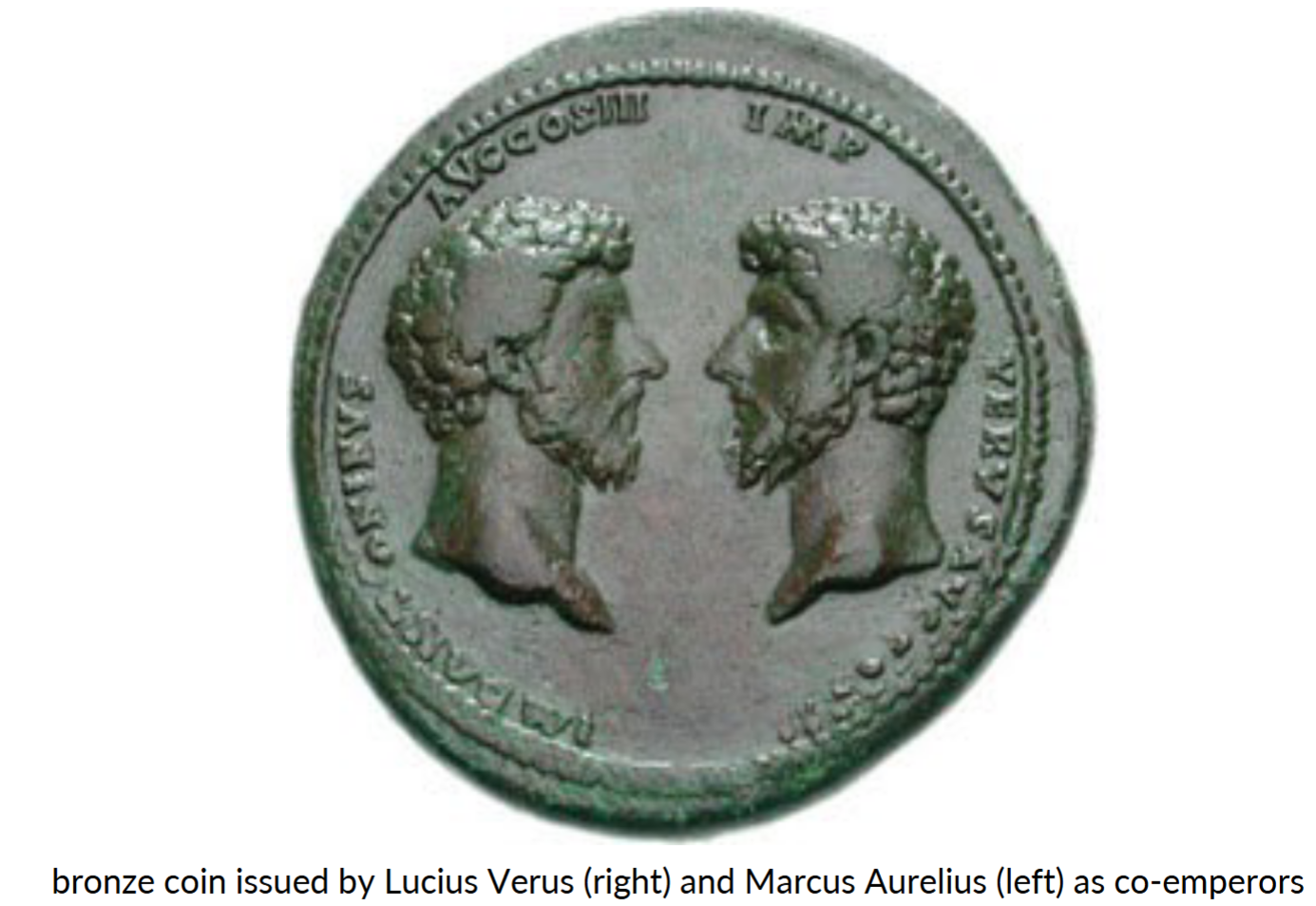
Hadrian’s adoption of Antoninus Pius; Antoninus’ adoption of Marcus Aurelius & Lucius Verus
Hadrian adopts Antoninus Pius and makes him adopt Marcus Aurelius and Lucius Verus
co-rule for several years before Lucius Verus dies
Attempt to ensure stable transfer of power, avoid struggle for power/civil war
backup successor
Marcus Aurelius succeeded by son Commodus, who is extremely unpopular and eventually assassinate
ends Nerva-Antonine dynasty
circuses, Circus Maximus; chariot racing
Circus races at public expense
most famous is Circus Maximus in Rome
Allows populace to express opinions to emperors and other officials
Interact between emperor and subject at races, emperors who did not attend were unpopular
panem et circenses (bread and circuses)

amphitheaters, Flavian amphitheater/Colosseum; gladiators, gladiatorial games
Use of spectacles for social control and manipulation
Demonizing of gladiators and victims unifies spectators
Bread and circuses
condemnation ad bestias (to the beasts)
Events that pitted men against beasts
people found guilty of capital crimes condemned to the beasts
Roman liking of blood sports
Demonizing of victims unifies spectators
tool of political control/manipulation
Antoninus Pius
Hadrian’s successor
Antonines rely heavily on links to predecessors in imperial messaging and portraiture
Harmony between emperor and senate
Stability and organization
Power passed smoothly to Marcus Aurelius and Lucius Verus
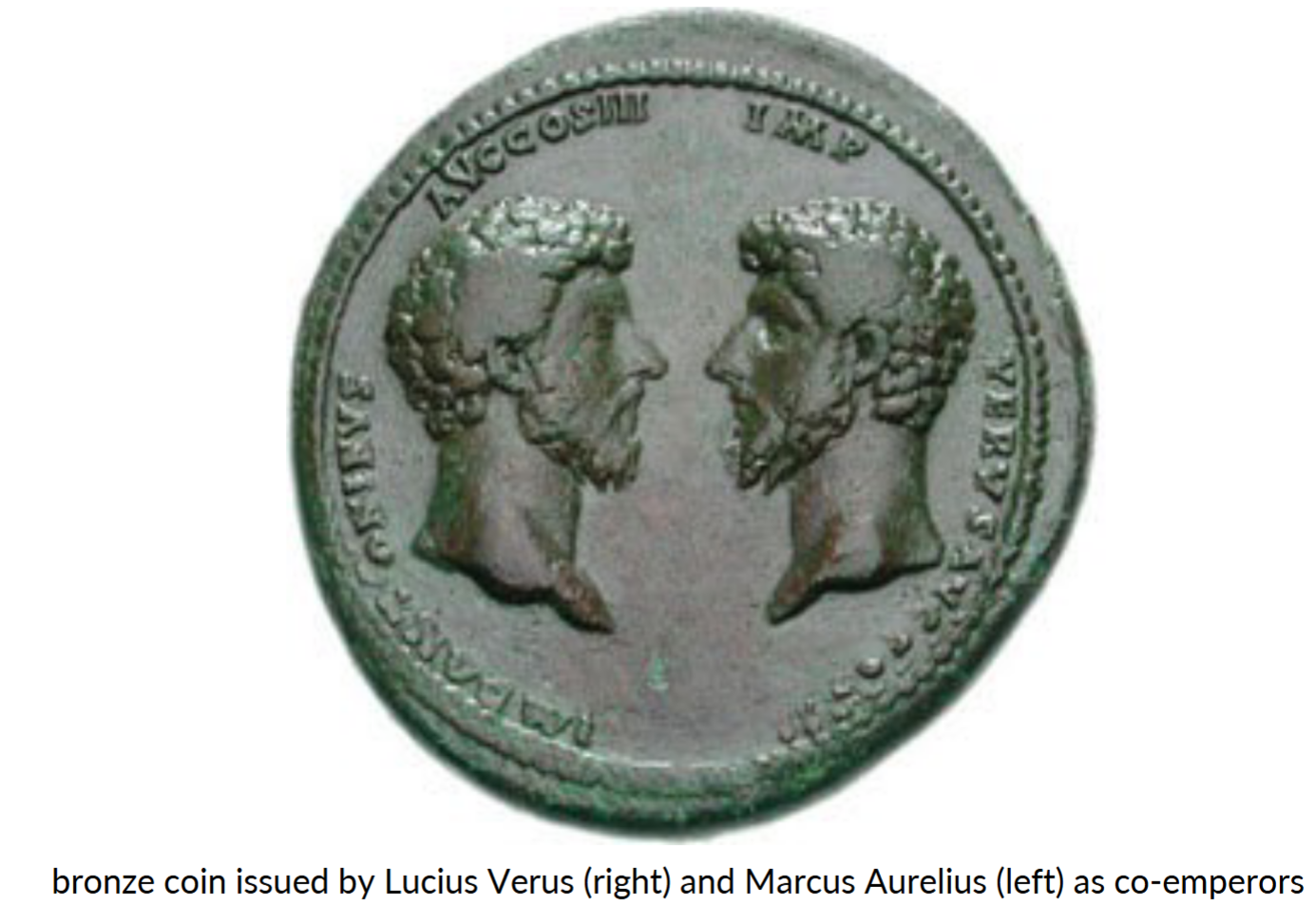
Marcus Aurelius and Lucius Verus
Co-rule for several years
Depictions emphasize equal status as co-heirs/emperors
Attempt to avoid conflict between claimants and problems with deaths of heirs
Desire to depict stability and continuity
Picture: coin depicting Marcus Aurelius and Lucius Verus as equals
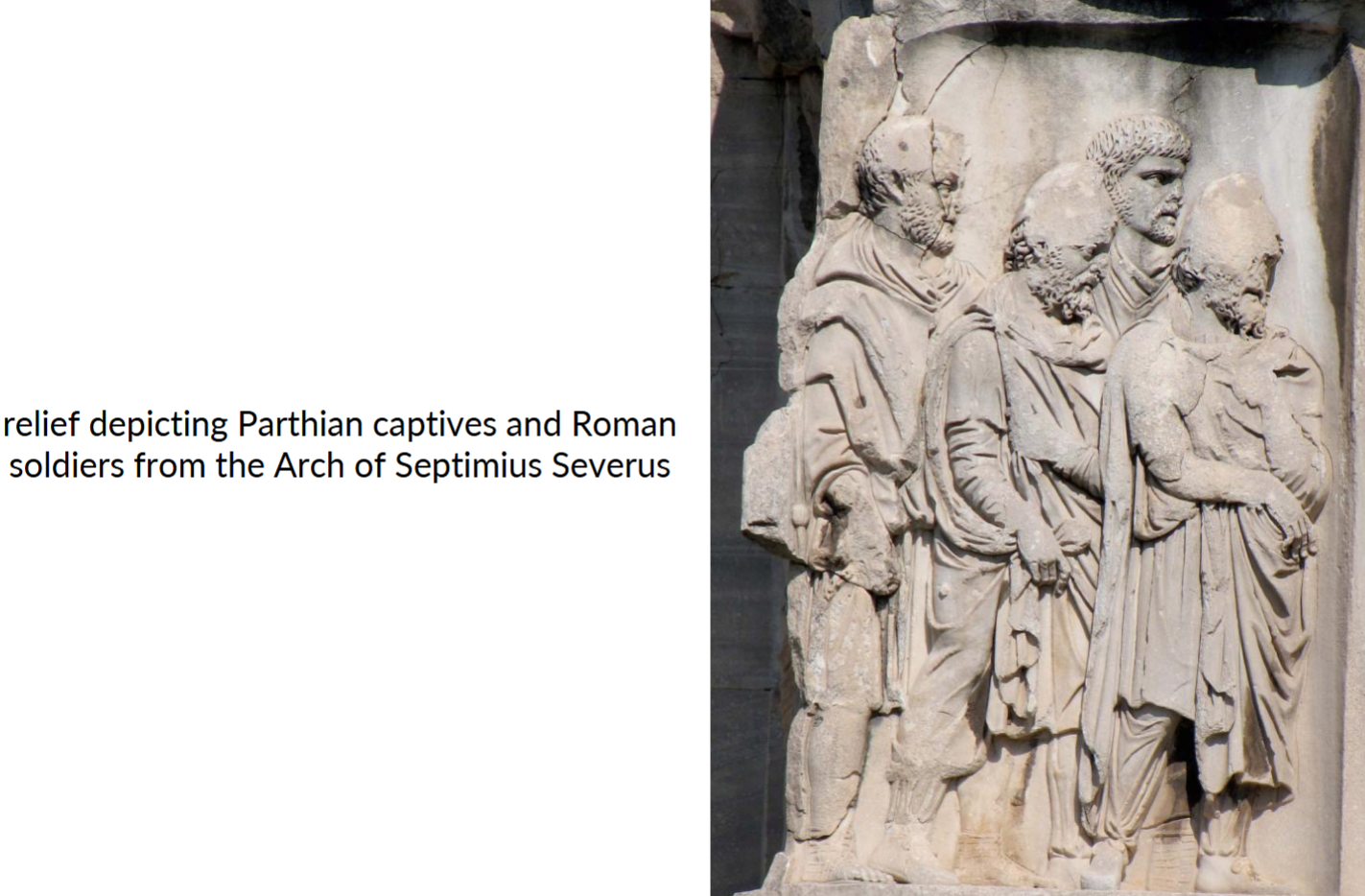
Parthia, Parthians; Parthian Wars
Fought primarily by Lucius Verus in the East
Joint triumph with Marcus Aurelius
Highlights deadlocked, evenly matched strength of the 2 empires

Commodus
Marcus Aurelius’ son, raised as potential heir from a young age
Joint Augustus with father, sole Augustus after his death
Exploits power and is hated
Criticized for abandoning military campaigns
Concerned with personal gratification and that of the masses
Self-presented as a god, Hercules
instability leads to assassination, ends Nerva-Antonine dynasty
Severan dynasty
Series of civil wars follows Commodus’ assassination
Conflicts end when general Septimius Severus takes control and has self adopted by Marcus Aurelius to establish legitimacy
Caracalla takes over after his death, establishing Severan dynasty
Septimius Severus
Army general
Takes control and ends series of civil wars
Has self posthumously adopted by Marcus Aurelius to establish legitimacy
Popular with troops
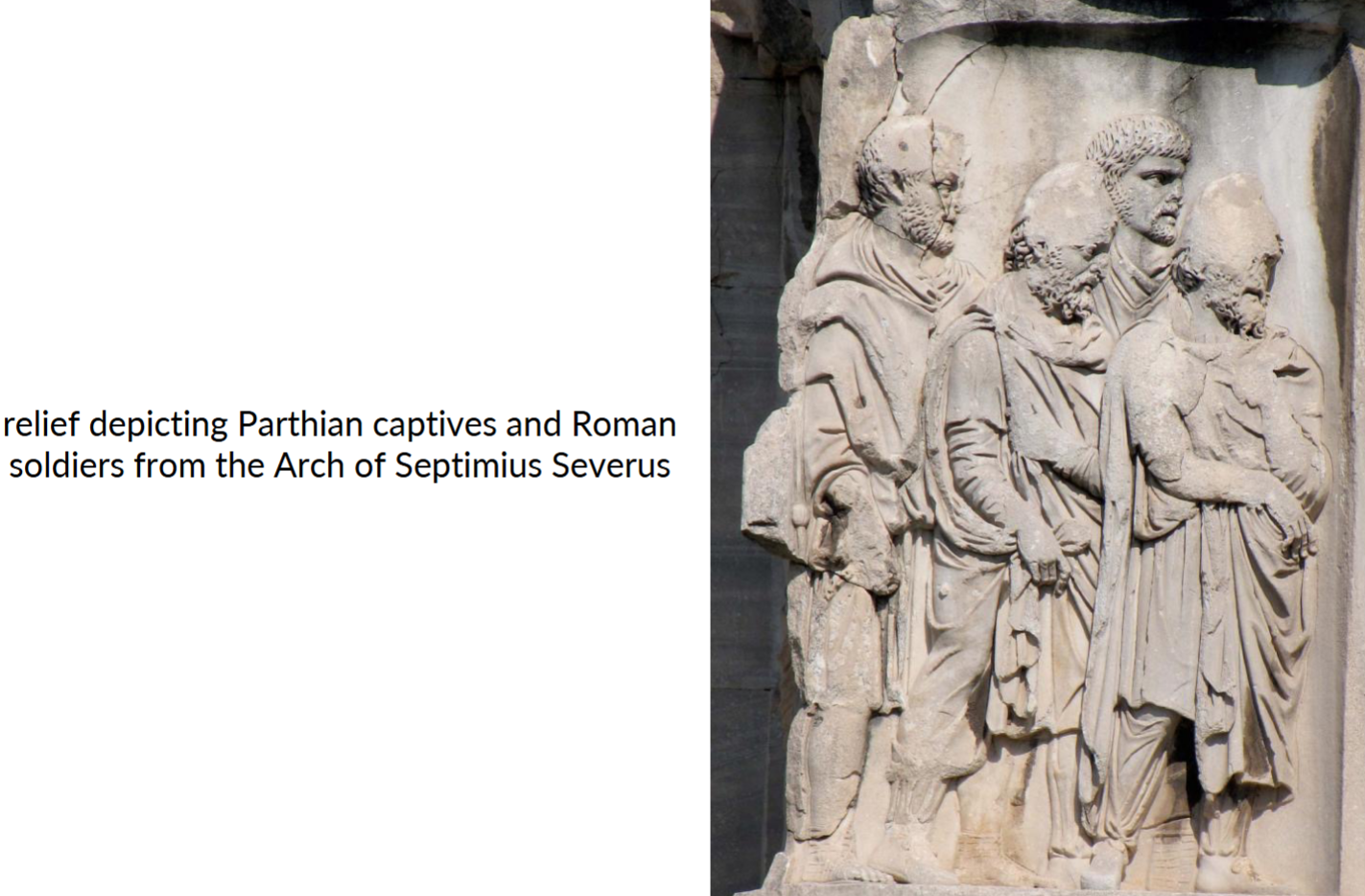
Arch of Septimius Severus
Commemorates defeat of Parthians
Placement in Forum drew connections to Augustus through proximity to Augustus’ own Parthian arch
Inscriptions mark dynastic ambitions
mentions Caracalla and Geta and depicts them in reliefs
Geta later erased

Julia Domna (wife of Septimius Severus and mother of Caracalla and Geta)
Called “Mother of the Camps” by the military
Demonstrates personal ties of Septimius Severus to the military
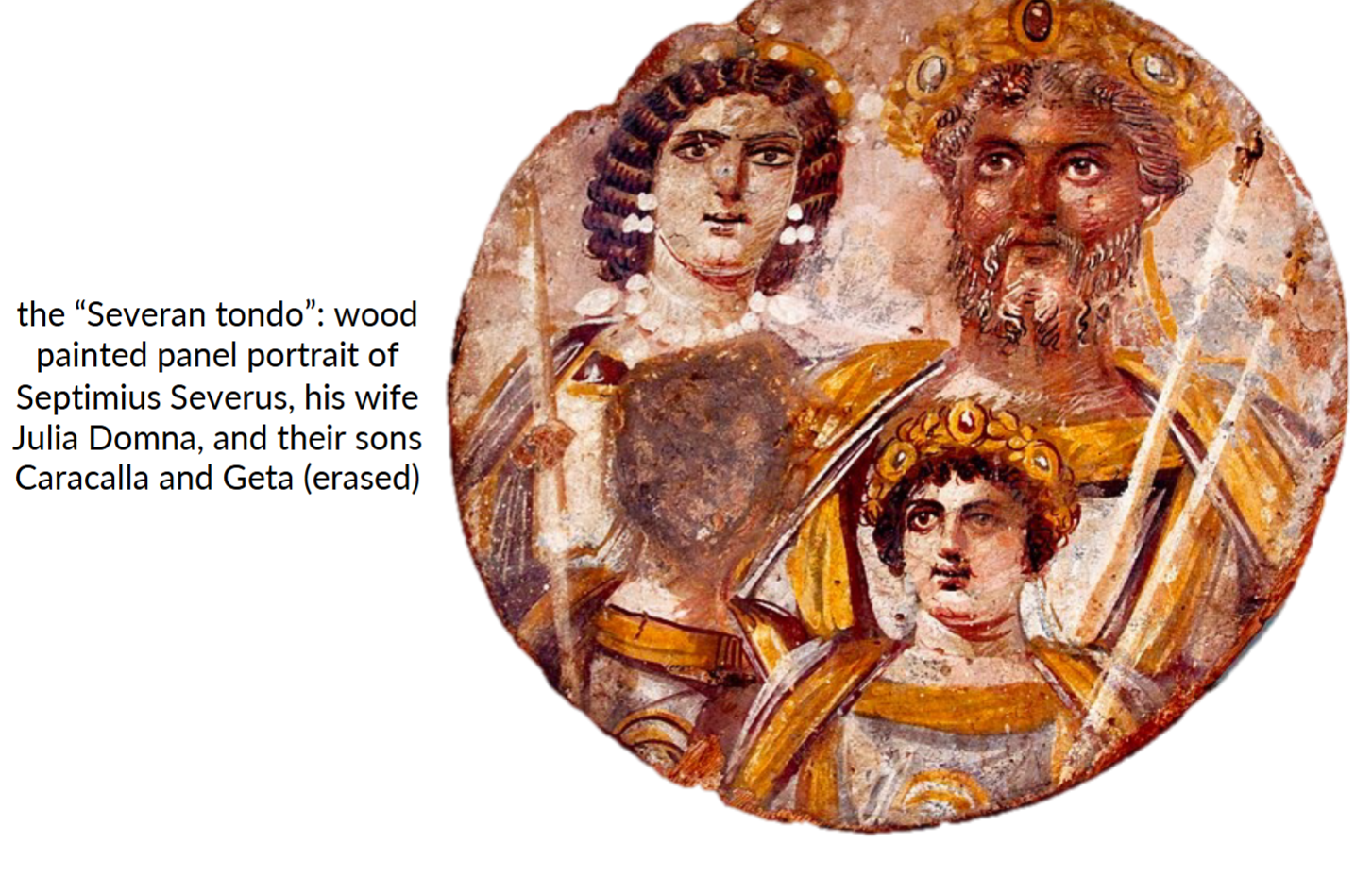
Caracalla and Geta
Sons of Septimius Severus and Julia Domna
Caracalla takes over when father dies, marking beginning of Severan dynasty
Caracalla extends Roman citizenship
Caracalla has Geta assassinated
Removes his name and image from imperial monuments
Caracalla eventually assassinated by his troops
Elagabalus/Heliogabalus
Took throne young, didn’t hold strong control, and was murdered quickly
Name derived from the son god of Emesa
Disliked
Severus Alexander
Took the throne young
Did not hold strong control and was murdered quickly
Reign was under a regent
Respected the senate, but not the military
Military thought he was a coward for attempting to negotiate for peace
assassinate him
Roman jurists, jurisprudence
Jurisprudence: the science of what is right and wrong
“what a good man would do”
Private law becomes more liberal and humane in first 250 years of principate
Legal reasoning
Jurists express belief in basic human equality
honestiores vs. humiliores
honestiores: “more honorable”
senators, equestrians, veterans, town councilors, well-educated
humiliores: “more lowly”
everyone else. most of population
Harsher legal penalties for humiliores
Constitutio Antoniniana
Issued by Caracalla, expands Roman citizenship
through honorable discharge from auxiliary forces
through enlistment in roman legions
through direct grant by emperor
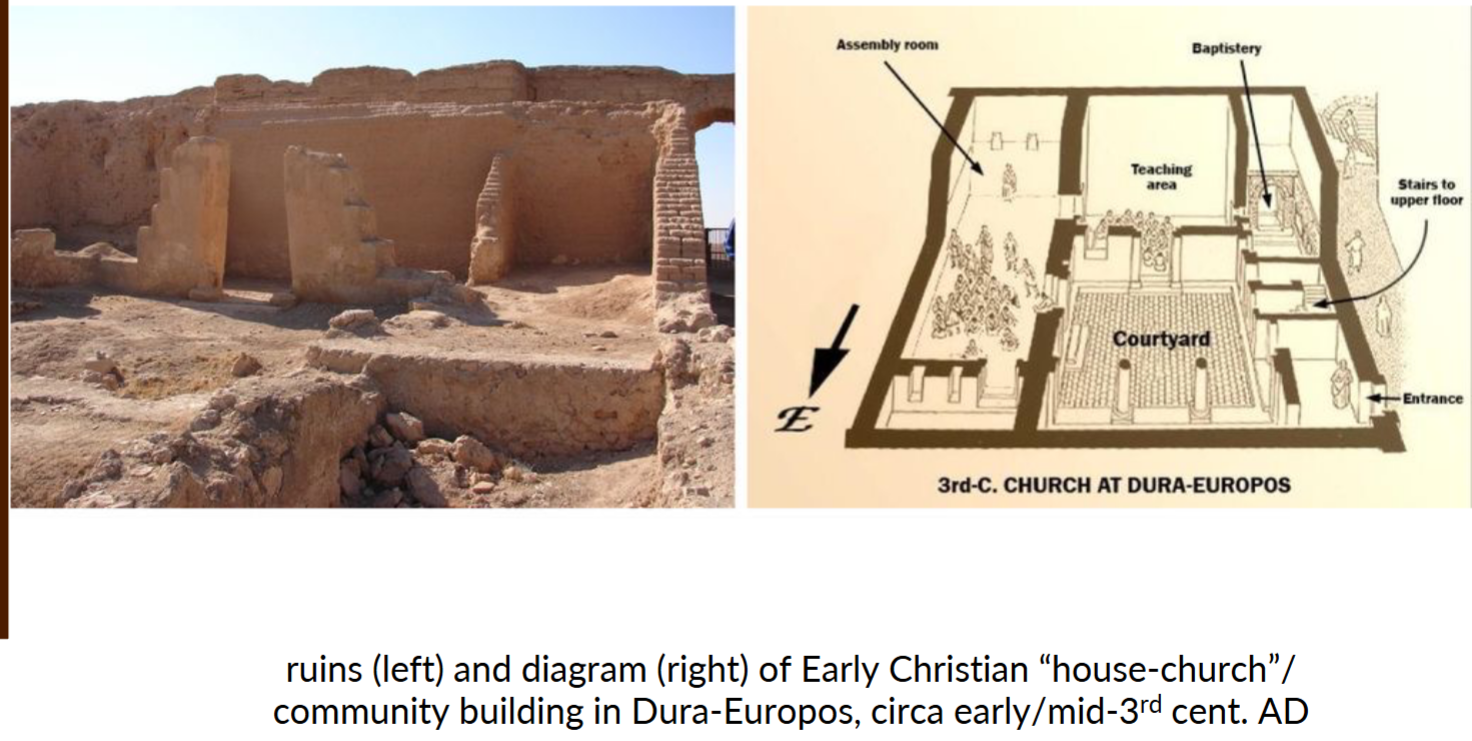
early Christianity
Becomes more problematic as it becomes more distinct from judaism
hostility because Christians refuse to assist the community in a civil or military capacity
Judaism
libelli (certificates)
mid-third century, all Romans must sacrifice to Roman gods
receive a certificate (libelli) to record compliance
To Christians, recorded their renunciation of Chrstianity
Thousands of Christians killed (mobs or execution)
martyrs, martyrdom
People who witnessed their faith through public refusal to deny it
bravery, unshakable faith
encouraged self-perception of christians as beleagured, suffering minority
converts, conversion
Conversion: deliberate public acts of religious commitment that acknowledged psychological change
revealed doctrine, initiation, dedicated priesthood, afterlife, community on earth
Similarities to mystery religions
Greater openness to converts than mystery religions, proselytizing, monotheism, emphasis on scripture, stress on belief and behavior
differences from mystery religions
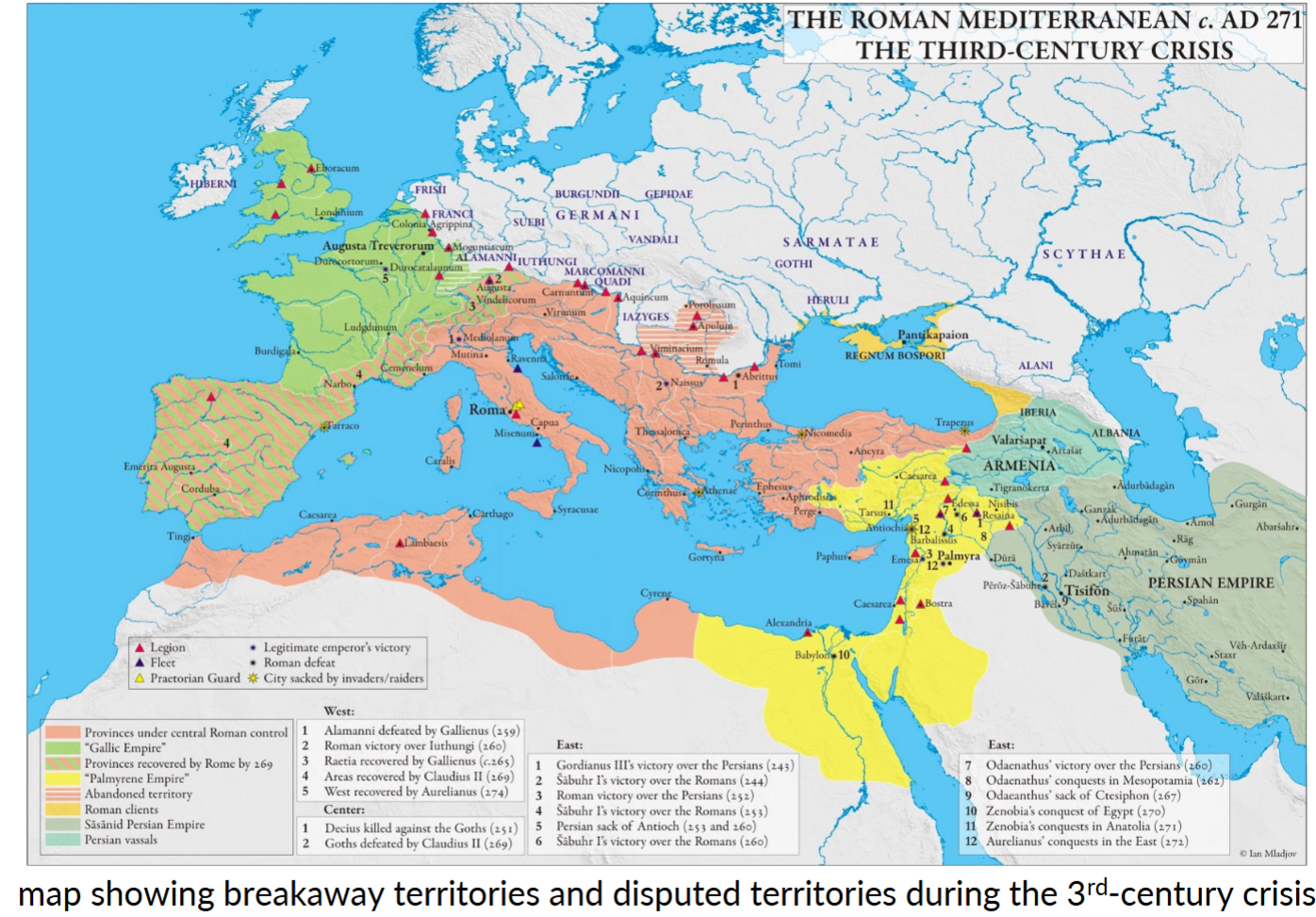
3rd century crisis
not on exam but study picture
Picture:
civil wars, short reigns of soldier emperors, chaos
characterized by instability and fracture in the empire
territorial control shrank; breakaway provinces and rival empires emerge
Rome losing control of its vast empire
soldier-emperors
series of emperors who ruled for short times during third century
declared emperor by troops
few major projects due to chaotic nature of reigns
increased importance of physical force to secure power
produced lots of art with distinctive and recognizable portraits
prioritized replacing images of predecessors
barbarian invasions
Persia, Sassanian Persians, Sassanians (Sasanians/Sassanids)
Palmyra, Palmyrene Empire; Zenobia
debasement, debased coinage
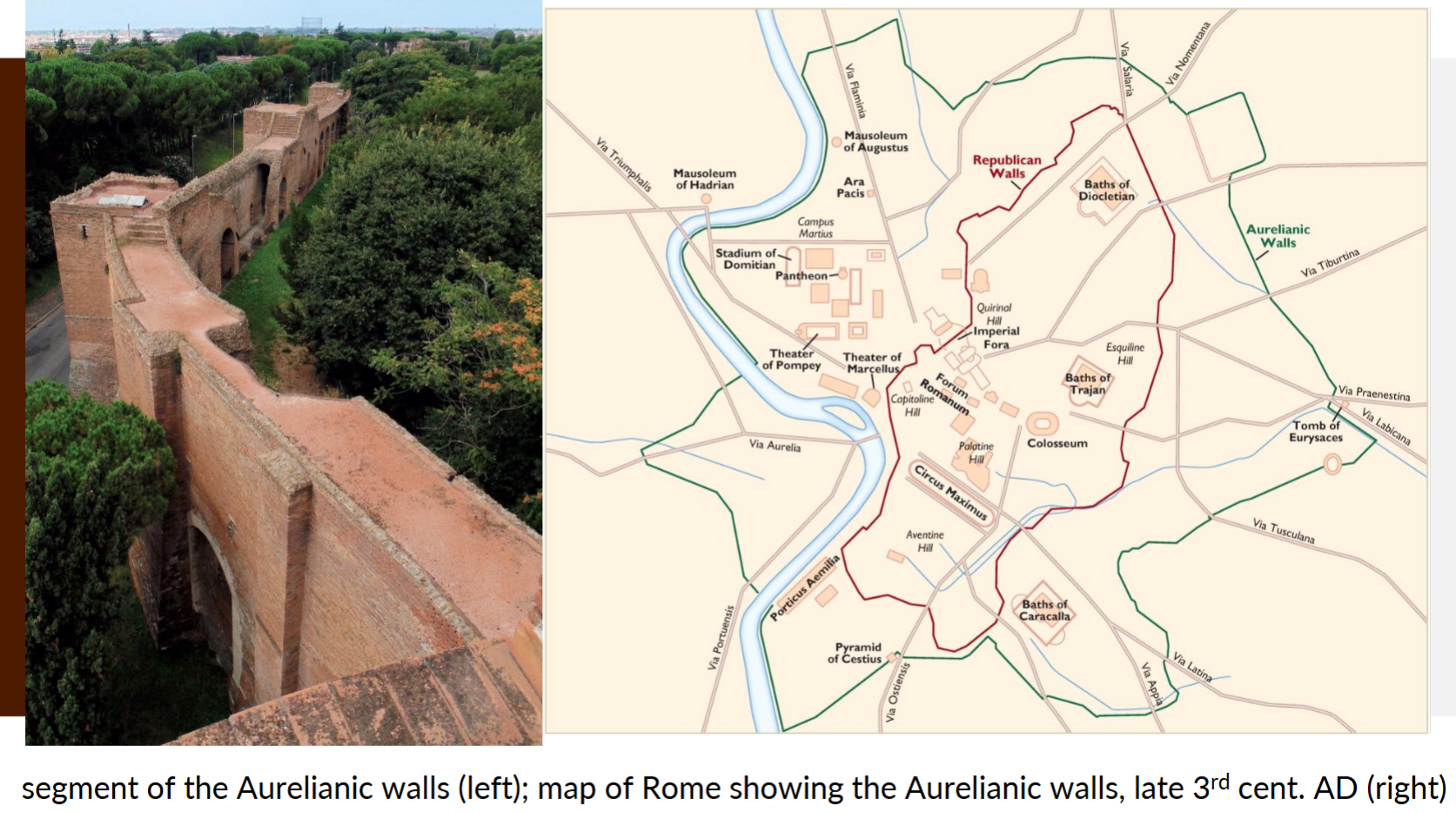
Aurelian, Aurelianic walls
Only major building project during 3rd century crisis/reigns of the soldier emperors
Built around Rome
encompasses more territory than earlier Republican walls
signifies fear over increasing barbarian invasions
Sol Invictus (the Unconquerable Sun god), cult of Sol Invictus
Diocletian
ends period of soldier emperors
names one of his generals, Maximian, his presumptive heir (Caesar)
raises Maximian to co-emperor (Augusti)
Splits administration of empire into east and west halves, one Augustus and one Caesar in each
tetrarchy
augustus of the east
Maximian
Diocletian’s general
Named presumptive heir (caesar)
elevated to co-emperor (Augustus)
augustus of the west
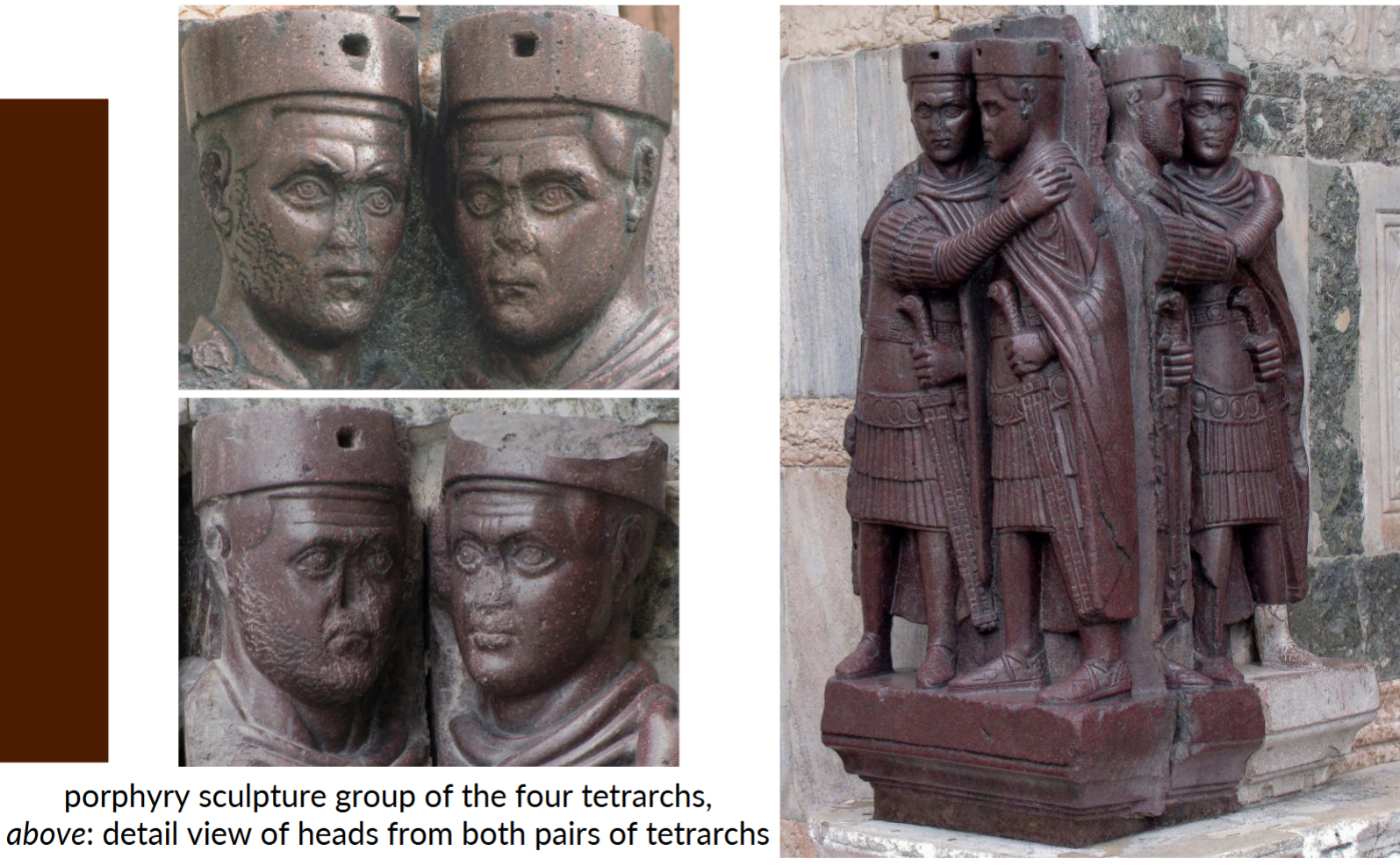
tetrarchy, tetrarchs
Rule by 4
new requirements for imperial ideology and iconography
intended message shifts from centralized absolute power to equal partnership and balanced division
Motifs:
shared power/authority, equals
lack of individuality in portraiture, interchangeable depictions
communication through symbols: iconogrpahic language for power
purple, orbs/globes, swords with eagle hilts
continued divine support for imperial power
Jupiter linked to all 4
Geographical shift of power:
center of empire shifts east of rome
Galerius
Caesar of the east
augustus is diocletian
Constantius
former caesar of the west, now elevated to augustus of the west
dies, troops elevate his son constantine
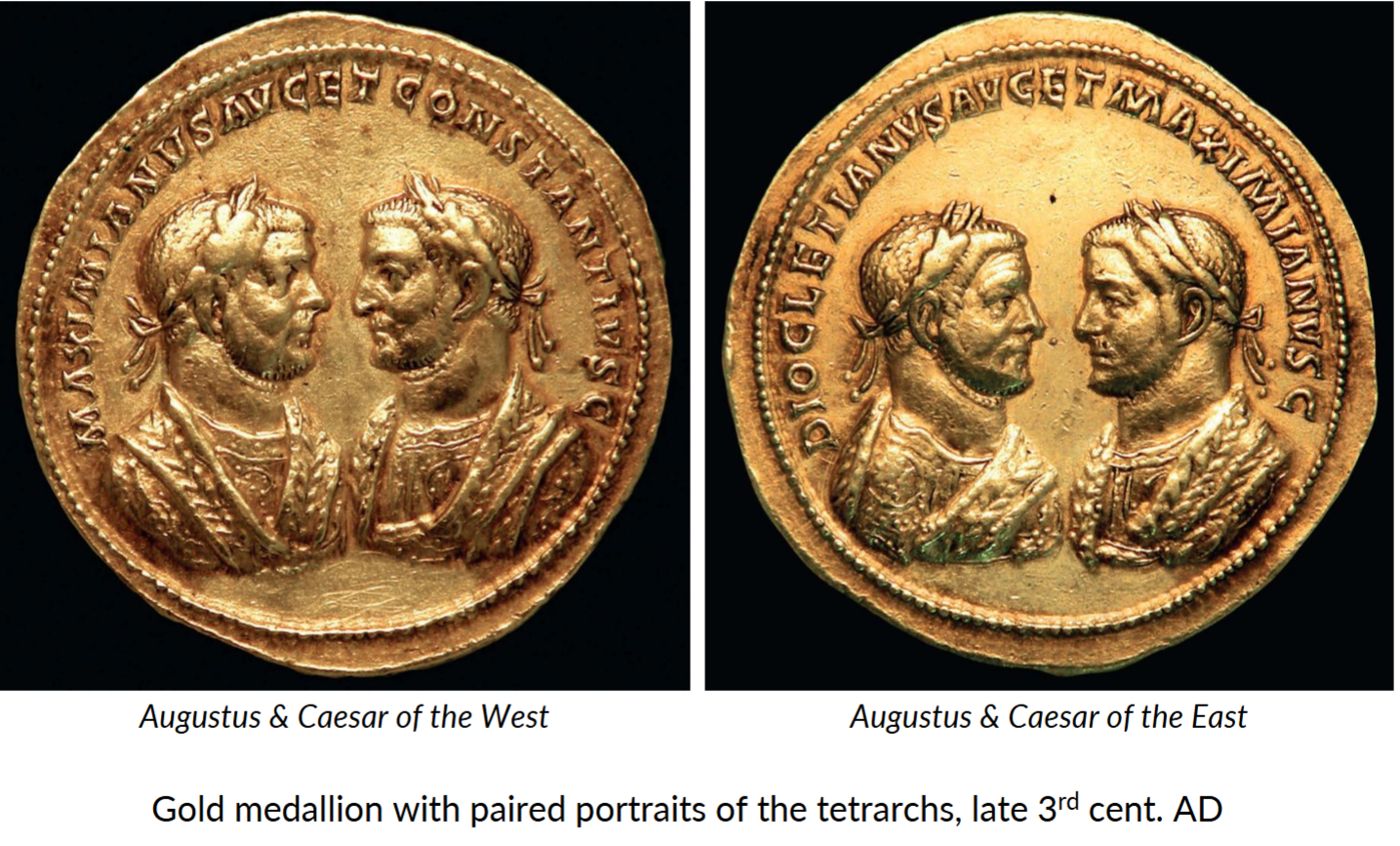
Augusti and Caesares
Diocletian splits administration of empire into east and west halves, one Augustus and one Caesar in each
tetrarchy
shared power, equality
Picture: Augustus portrayed as older than caesar, but all four are still equals
attempt to maintain stability and order across empire by splitting it in two but not allowing one man to have control over either half
Diocletian’s abdication
Sick, retires, forces Maximian to abdicate as well
civil wars break out again
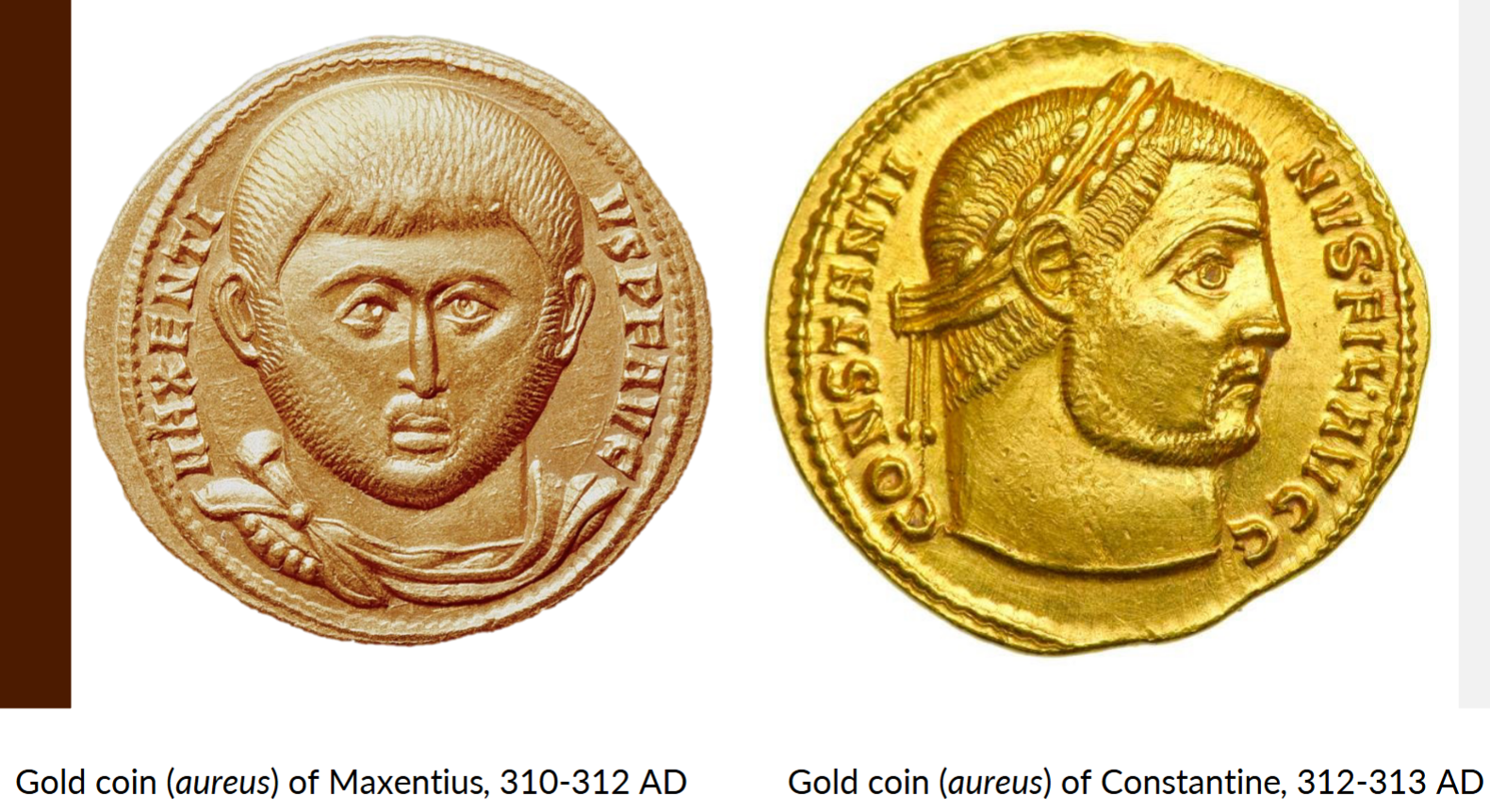
Maxentius
son of maximian
conflict between him and Constantine for western throne
defeated by constantine at battle of milvian bridge

Constantine
Son of contantius
conflict between him and Maxentius for western throne
defeats maxentius at battle of milvian bridge
issues edict of milan